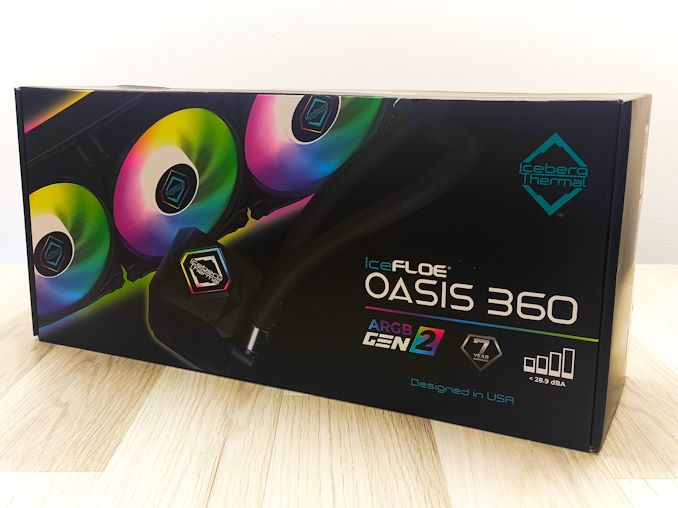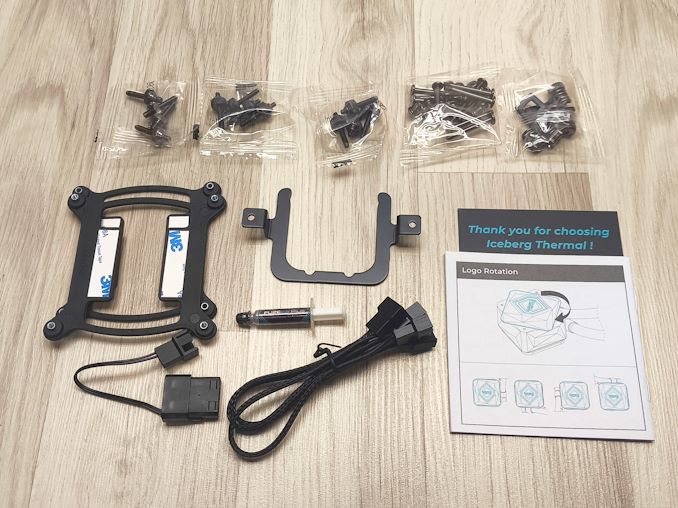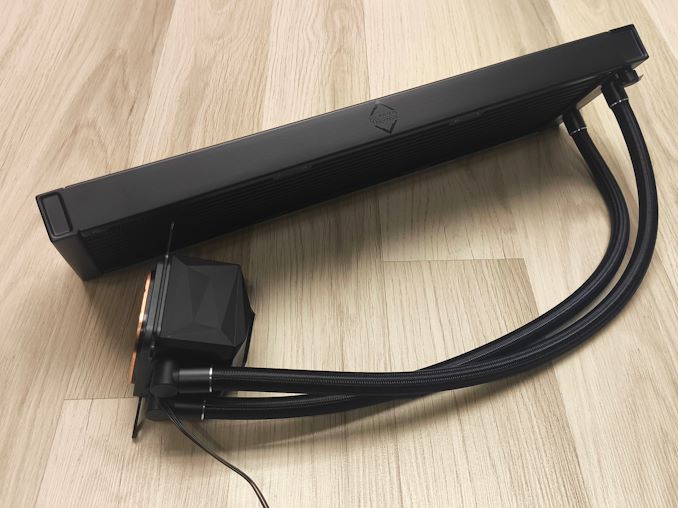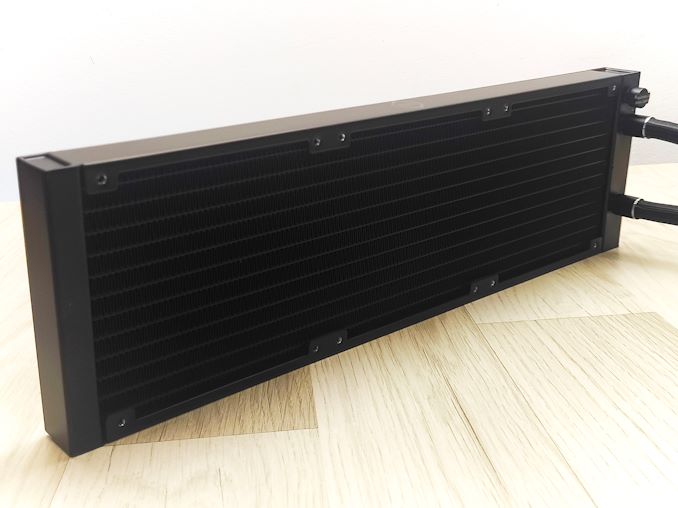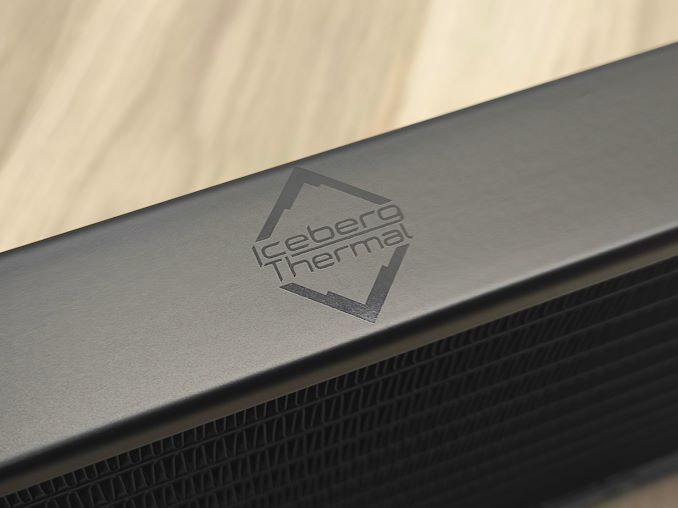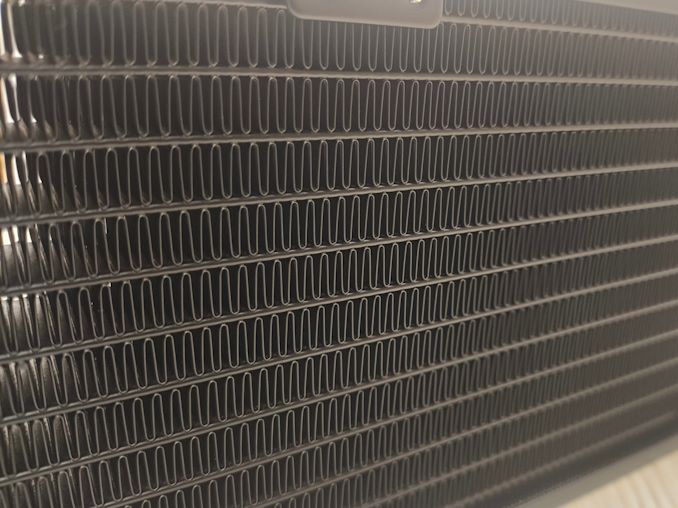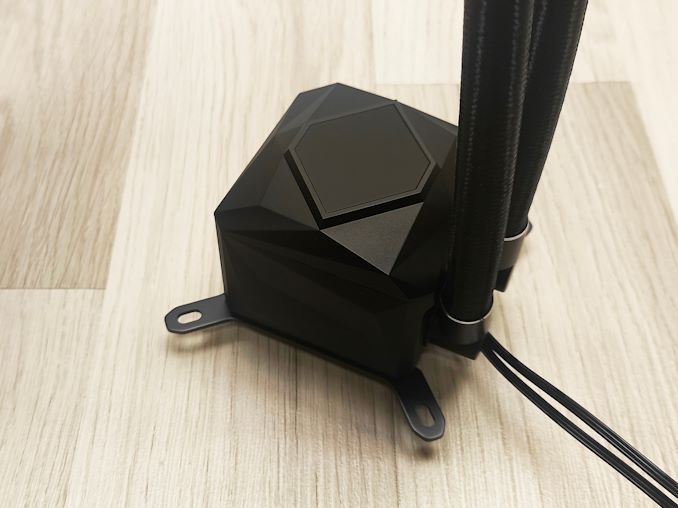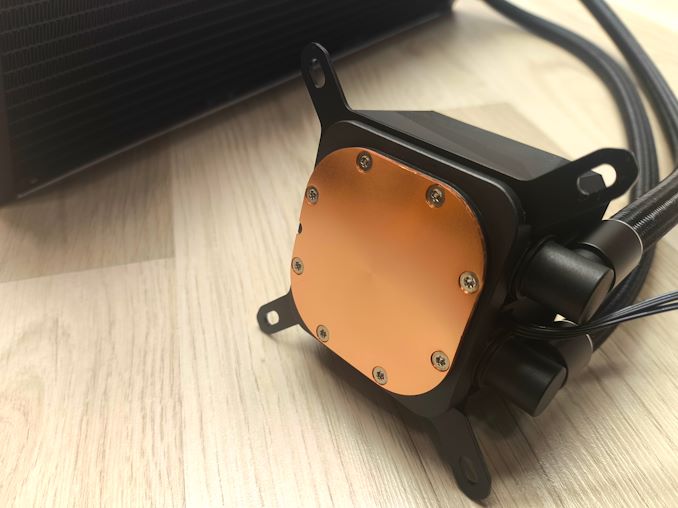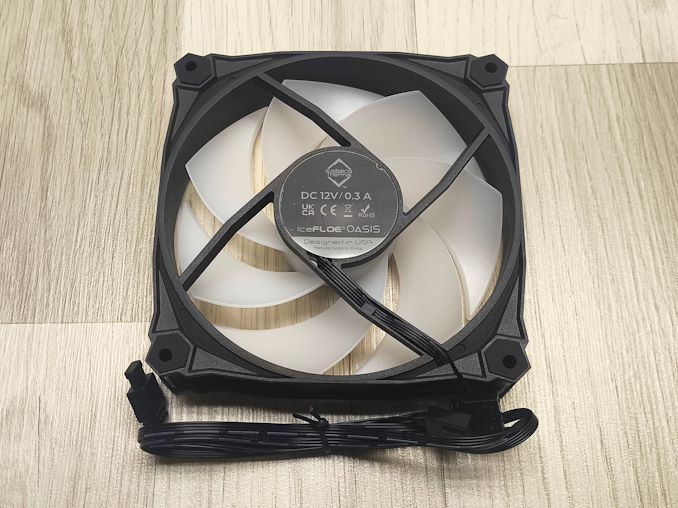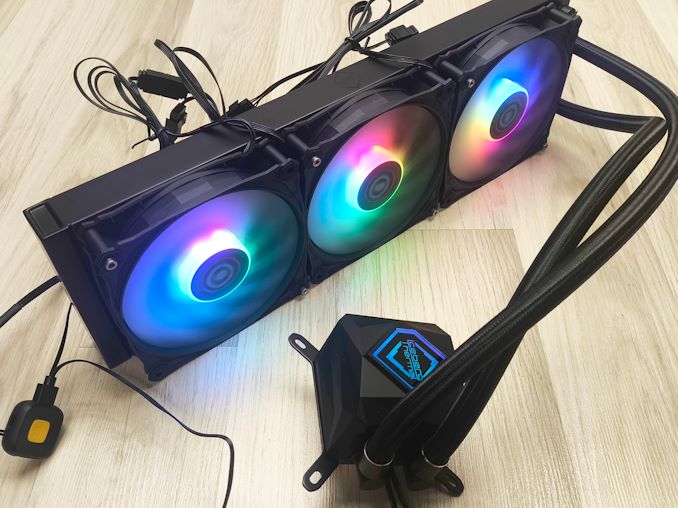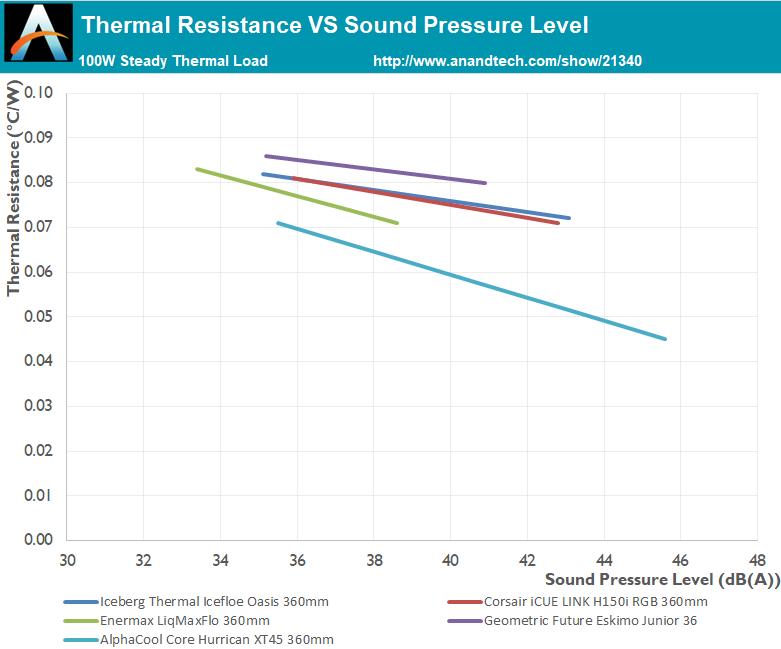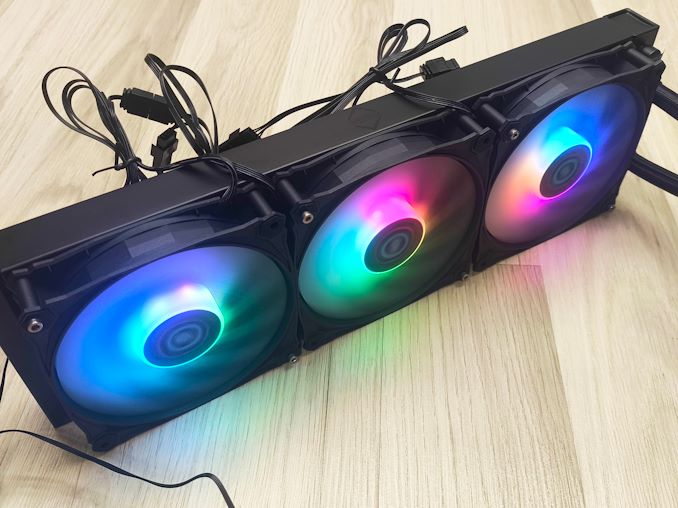Iceberg Thermal Inc. is one of the newer players in the PC cooling market. The company was founded in 2019 by an experienced team of designers and engineers setting off on their own, aiming to deliver a wide range of PC cooling products to industrial and commercial users alike. They only have a handful of retails products currently available, with the vast majority of them being CPU air coolers, but they have just launched their first liquid cooler products, the IceFLOE Oasis series.
In today’s review, we are having a look at the IceFLOE Oasis 360mm AIO (All-In-One) CPU cooler, the larger of the company’s two recently-released liquid coolers. The IceFLOE Oasis CPU cooler targets the high-performance PC cooling market with a sub-$100 price point, aiming to deliver the performance needed to effectively cool a power-hungry processor without being a drain on the wallet in the process. This cooler features a 360mm radiator for an ample heat dissipation area, as well as housing for three high-airflow 120 mm fans. The IceFLOE Oasis supports a wide range of Intel and AMD socket types, making it compatible with a broad spectrum of CPUs. Additionally, it offers advanced RGB lighting, allowing users to customize the aesthetic of their cooling system.
| Iceberg Thermal IceFLOE Oasis 360mm (IFOA36-BAN) Cooler Specifications |
|||
| Type | All-in-One Liquid Cooler | ||
| Dimensions | 397 x 120 x 52 mm (radiator with fan)
56 x 56 mm (coldplate) |
||
| Fans | 3 x 120 mm FDB Bearing Fans 2200 RPM (max) |
||
| RGB | Yes (ARGB Gen 2) | ||
| Supported Sockets | Intel: LGA1700 / LGA1851
AMD: AM5 / AM4 |
||
| Warranty | 7 Years | ||
| Price | $90 | ||
We received the IceFLOE OASIS 360 AIO CPU cooler in a black cardboard box with an oversaturated image of the cooler itself covering most of its front side, in an attempt from the designer to highlight its ARGB Gen 2 compliance. Within the packaging, the cooler is encased in custom-designed cardboard inserts, carefully crafted to protect it throughout shipping and handling, thus guaranteeing its arrival in flawless condition.
The items bundled with the IceFLOE OASIS 360 are the minimum required for the cooler’s installation on a CPU. Aside from the mounting hardware, there is also a 3-in-1 4-pin connector for the radiator’s fans, a 4-pin to Molex connector should someone want to plug the pump or the fans directly to the PSU, and a syringe with premium thermal material. We should note that there is no ARGB controller included, meaning that the RGB lighting requires a compatible motherboard or third-party controller to function.
At first sight, the Iceberg Thermal IceFLOE Oasis 360mm AIO CPU cooler presents a design that is consistent with the conventional layout of advanced 360 mm AIO coolers in the market. This cooler maintains the typical AIO structure, consisting of a single large radiator, two hoses, and an integrated pump-block assembly. The block encompasses a copper CPU contact plate (or coldplate) alongside an efficiently designed liquid pump, the most typical AIO cooler block setup. Iceberg Thermal opts for durable rubber hoses encased in braided sleeving for enhanced protection, sacrificing some flexibility for additional durability.
The Iceberg Thermal IceFLOE OASIS 360 mm AIO features a radiator that is 27 mm thick, the most typical thickness of an AIO cooler radiator, ensuring compatibility with virtually any case designed to house a 360 mm radiator. The design of the radiator follows the common dual pass cross-flow configuration, with small fins attached to thin, elongated tubes. A tap is present on the radiator, possibly for maintenance or refilling, yet a sticker warning that the warranty will be void if removed is placed on it. The company’s logo is laser etched on the side of the radiator.
The main block the Iceberg Thermal IceFLOE Oasis 360mm AIO cooler features a design focused on aesthetic integration. Constructed primarily from durable plastic, with a top cover that is adjustable by 90° for a perfect alignment of the decorative logo with the motherboard. The logo is not visible until the ARGB connector receives a signal. The unit is fitted with 90° connectors on its side to attach both hoses smoothly, and it houses two cables: one is a 4-pin connector for power, and the other supports the RGB lighting. The RGB functionality offers versatility, allowing connection to either the provided controller or any compatible RGB system for customizable lighting effects.
On the underside of the main block assembly of the Iceberg Thermal IceFLOE Oasis 360mm AIO cooler, there’s a squircle-shaped contact plate affixed to the plastic body with eight screws. The surface of the plate, while not mirror-polished, is sufficiently smooth and flat for effective thermal transfer. The cooler does not come pre-applied with thermal paste; instead, a syringe of thermal compound is included for application during installation. The dimensions of the coldplate are approximately 56×56 mm, ensuring it covers the entirety of the CPU dies it is compatible with.
Iceberg Thermal provides three 120 mm fans rebranded under their own logo. The three fans are high airflow low pressure designs, with seven narrow blades. Their operational range is very wide, ranging from 200 to 2200 RPM, giving the IceFLOE OASIS 360 cooler a great deal of versatility. It has a Fluid Dynamic Bearing (FDB) engine, which are a balance between top reliability and quiet operation. Their cables allow both the ARGB and the power connectors to be connected in parallel (daisy-chain) but they are of normal length and can easily cause a clutter if not installed with care.
Iceberg Thermal, in designing the RGB lighting for the IceFLOE Oasis 360mm AIO cooler, adhered to traditional lighting schemes, opting for a semi-transparent fan hub with internal LED placement for the fans and a backlit logo on the main block. The illumination provided is bright and fairly uniform, although the intensity tends to decrease towards the blade’s edges. Dimming the lights makes the spacing between LEDs clearly visible, as the LEDs are powerful but not numerous. While this lighting approach might not set new benchmarks in current RGB trends, it suffices for a majority of users, aside from those with very specific demands for their system’s aesthetic.
Although the testing of a cooler appears to be a simple task, that could not be much further from the truth. Proper thermal testing cannot be performed with a cooler mounted on a single chip, for multiple reasons. Some of these reasons include the instability of the thermal load and the inability to fully control and or monitor it, as well as the inaccuracy of the chip-integrated sensors. It is also impossible to compare results taken on different chips, let alone entirely different systems, which is a great problem when testing computer coolers, as the hardware changes every several months. Finally, testing a cooler on a typical system prevents the tester from assessing the most vital characteristic of a cooler, its absolute thermal resistance.
The absolute thermal resistance defines the absolute performance of a heatsink by indicating the temperature rise per unit of power, in our case in degrees Celsius per Watt (°C/W). In layman’s terms, if the thermal resistance of a heatsink is known, the user can assess the highest possible temperature rise of a chip over ambient by simply multiplying the maximum thermal design power (TDP) rating of the chip with it. Extracting the absolute thermal resistance of a cooler however is no simple task, as the load has to be perfectly even, steady and variable, as the thermal resistance also varies depending on the magnitude of the thermal load. Therefore, even if it would be possible to assess the thermal resistance of a cooler while it is mounted on a working chip, it would not suffice, as a large change of the thermal load can yield much different results.
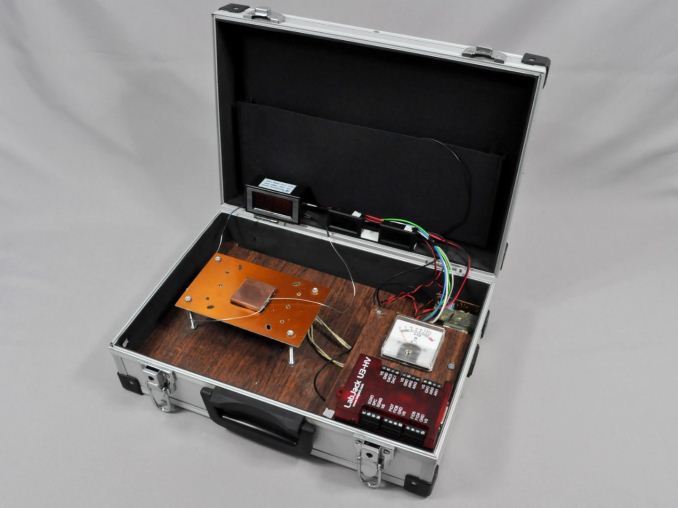
Appropriate thermal testing requires the creation of a proper testing station and the use of laboratory-grade equipment. Therefore, we created a thermal testing platform with a fully controllable thermal energy source that may be used to test any kind of cooler, regardless of its design and or compatibility. The thermal cartridge inside the core of our testing station can have its power adjusted between 60 W and 340 W, in 2 W increments (and it never throttles). Furthermore, monitoring and logging of the testing process via software minimizes the possibility of human errors during testing. A multifunction data acquisition module (DAQ) is responsible for the automatic or the manual control of the testing equipment, the acquisition of the ambient and the in-core temperatures via PT100 sensors, the logging of the test results and the mathematical extraction of performance figures.
Finally, as noise measurements are a bit tricky, their measurement is being performed manually. Fans can have significant variations in speed from their rated values, thus their actual speed during the thermal testing is being recorded via a laser tachometer. The fans (and pumps, when applicable) are being powered via an adjustable, fanless desktop DC power supply and noise measurements are being taken 1 meter away from the cooler, in a straight line ahead from its fan engine. At this point we should also note that the Decibel scale is logarithmic, which means that roughly every 3 dB(A) the sound pressure doubles. Therefore, the difference of sound pressure between 30 dB(A) and 60 dB(A) is not “twice as much” but nearly a thousand times greater. The table below should help you cross-reference our test results with real-life situations.
The noise floor of our recording equipment is 30.2-30.4 dB(A), which represents a medium-sized room without any active noise sources. All of our acoustic testing takes place during night hours, minimizing the possibility of external disruptions.
| <35dB(A) | Virtually inaudible |
| 35-38dB(A) | Very quiet (whisper-slight humming) |
| 38-40dB(A) | Quiet (relatively comfortable – humming) |
| 40-44dB(A) | Normal (humming noise, above comfortable for a large % of users) |
| 44-47dB(A)* | Loud* (strong aerodynamic noise) |
| 47-50dB(A) | Very loud (strong whining noise) |
| 50-54dB(A) | Extremely loud (painfully distracting for the vast majority of users) |
| >54dB(A) | Intolerable for home/office use, special applications only. |
*noise levels above this are not suggested for daily use
Our maximum speed testing is performed with both the fans and the pump of the kit powered via a 12V DC source. This input voltage should have the pump and fans matching the speed ratings of the manufacturer. According to the company’s specifications, the fans included with the IceFLOE Oasis should have a rotational speed of 2200 RPM. Our tachometer indicated that the fans were rotating at an average speed of 2220 RPM, very close to the rated specifications and consistent to each other.

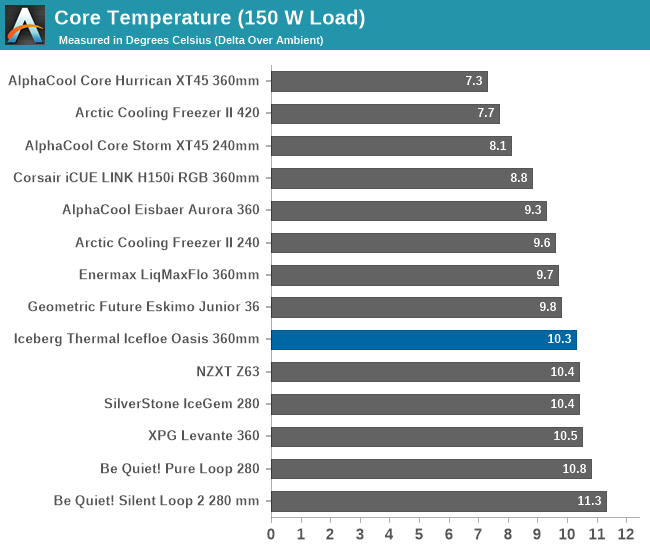
| Core Temperature, Constant Thermal Load (Max Fan Speed) |
The Iceberg Thermal IceFLOE Oasis 360mm cooler demonstrates exceptional performance under various load conditions, with an average thermal resistance of 0.0665 °C/W when the fans are operating at their maximum speed of 2220 RPM. The thermal efficiency of this cooler remains stable across different levels of demand. This level of performance is noteworthy but one should take into account that the maximum fan speed is fairly high in comparison to similar products in the market.
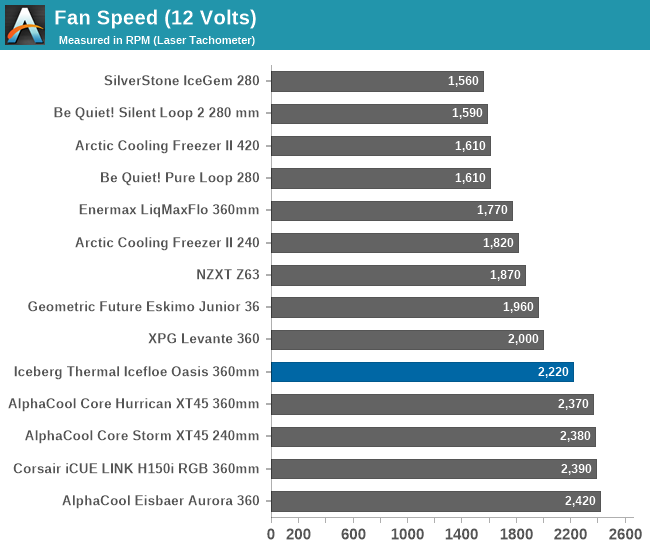
The Iceberg Thermal IceFLOE Oasis 360mm cooler, generating 43.1 dB(A) of noise at full fan speed, is quite audible, but it is within the expected limits considering it is equipped with three powerful 120mm fans. Although high, the noise figure is comparative to that of other coolers sharing the same design, indicating that Iceberg Thermal is using fans of at least equivalent quality and there are no major design flaws that could be causing the noise to be higher than expected. We should also note that the pump of the unit is powerful and audible if the fans are not powered
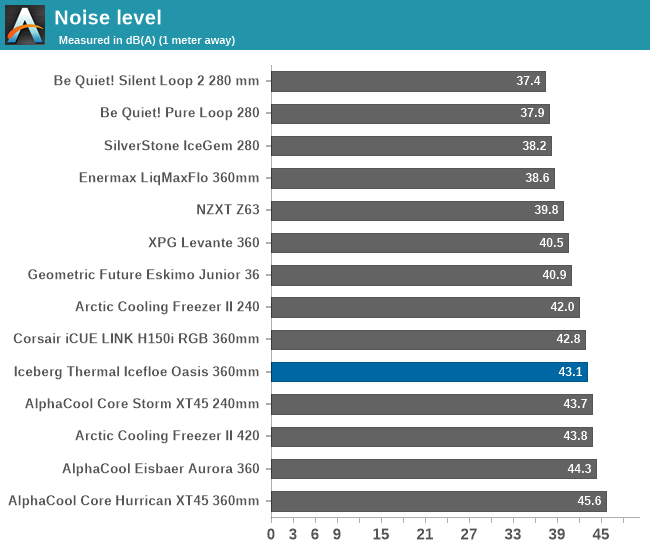
Using a PWM voltage regulator, we reduced the speed of the fans manually down to half their rated speed. At this setting, the 120 mm fans of the IceFLOE Oasis rotate at 1100 RPM.
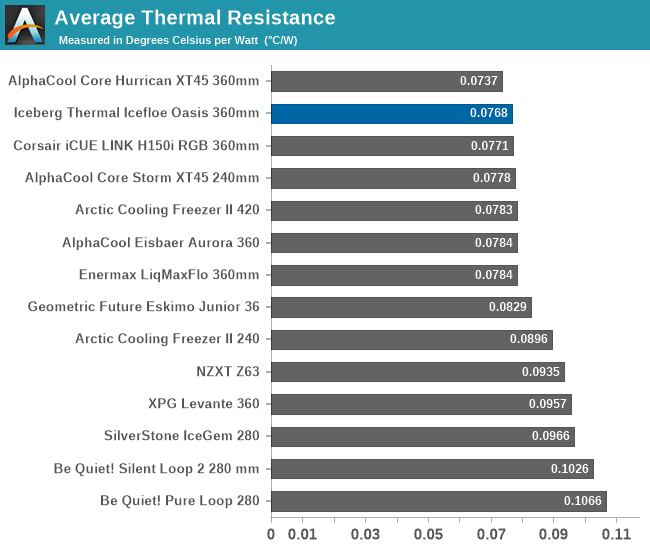
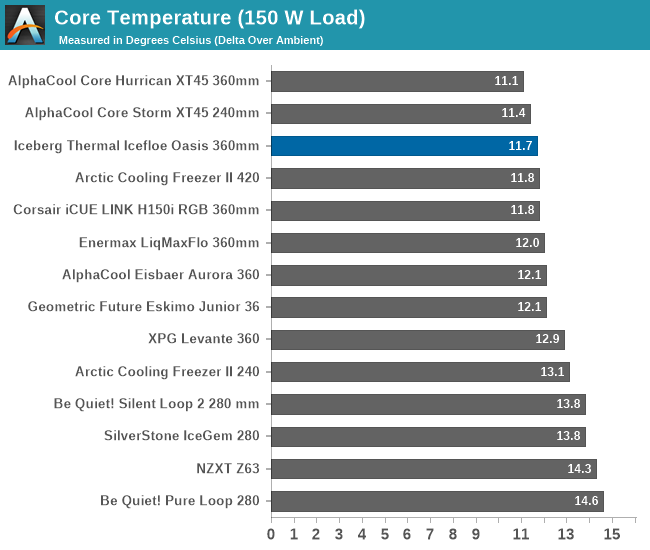
| Core Temperature, Constant Thermal Load (Low Fan Speed) |
The Iceberg Thermal IceFLOE Oasis 360mm cooler achieves remarkable cooling efficiency, showing an average thermal resistance of 0.0768 °C/W with its fans operating at 1100 RPM. This performance places it among the leading options in our charts so far, achieving levels of raw thermal performance that rival those of significantly pricier and more intricate custom loop cooling solutions.
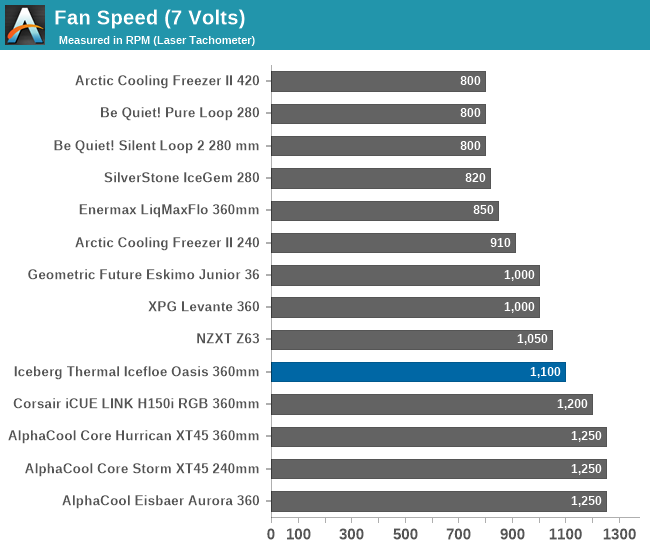
The acoustic performance of the Iceberg Thermal IceFLOE Oasis 360mm cooler is moderate when its fans are set to half speed. At this lower speed of 1100 RPM, the cooler produces a noise level of 35.1 dB(A), marking it as a middle-range option in terms of noise, even among cooling solutions equipped with three fans.
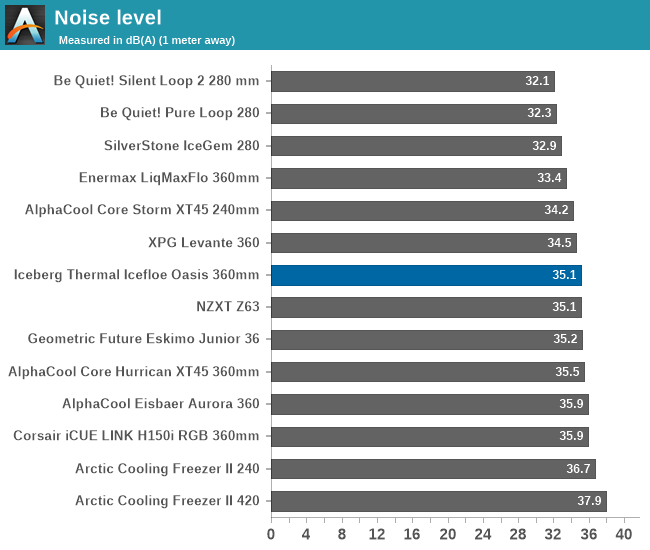
During our thermal resistance vs. sound pressure level test, we maintain a steady 100W thermal load and assess the overall performance of the coolers by taking multiple temperature and sound pressure level readings within the operating range of the stock cooling fans. The result is a graph that depicts the absolute thermal resistance of the cooler in comparison to the noise generated. For both the sound pressure level and absolute thermal resistance readings, lower figures are better.
This chart offers enlightening details on the performance of the Iceberg Thermal IceFLOE Oasis 360mm AIO Cooler. It reveals that the IceFLOE Oasis delivers thermal efficiency on par with one of its direct competitors in terms of size, the Corsair iCUE LINK H150i, and surpasses the Geometric Future Eskimo 36, highlighting its superior design. Although it slightly trails behind the Enermax LiqMaxFlo, this is largely due to the Enermax model’s utilization of a thicker radiator. The IceFLOE Oasis achieves its commendable thermal performance through its very powerful 120 mm fans that do produce significant noise at their maximum speed but, from what can see from the chart, the noise-to-performance ratio of the cooler is very good.
The Iceberg Thermal IceFLOE Oasis 360mm AIO CPU Cooler stands out in the competitive cooling market with a retail price of $90 – reaching budget pricing by 360 mm AIO cooler standards – marking it as an exceptionally competitive choice. It is designed for both enthusiasts and everyday users, balancing high performance with visual appeal, making it a versatile addition to a wide range of PC setups. This cooler retains the classic AIO configuration but sets itself apart with notable features such as a standard 27mm radiator for broad compatibility, durable rubber hoses with braided sleeving for added protection, and an integrated pump-block assembly that showcases a distinct aesthetic with its adjustable ARGB logo.
In terms of aesthetics, the IceFLOE Oasis combines practicality with contemporary design. The main block is made from sturdy materials with a customizable appearance thanks to ARGB lighting, lending a personalized flair to the setup. The radiator is discreetly branded with the Iceberg Thermal logo, enhancing its visual appeal without being visually overwhelming. The inclusion of a tap on the radiator for potential maintenance or refilling is a welcome addition.
The Iceberg Thermal IceFLOE Oasis 360mm AIO CPU Cooler delivers robust performance, marked by an average thermal resistance of 0.0665 °C/W at a maximum fan speed of 2220 RPM. At this speed, it produces a noise level of 43.1 dB(A), which, while high, is a trade-off for its cooling efficiency. When the fans are dialed down to 1100 RPM, the thermal resistance increases to 0.0768 °C/W and the noise level becomes more manageable. These figures position the IceFLOE Oasis as a competitive option in the AIO cooler market, offering a fairly good balance between cooling efficiency and noise, albeit with a noticeable sound footprint at higher speeds. Although it might not exceed the capabilities of more premium open-loop systems, its balance of thermal management and noise control is very competitive within its price bracket.
The Iceberg Thermal IceFLOE Oasis 360mm AIO CPU Cooler is a compelling option in the high-end cooling segment, offering a blend of effective cooling, attractive design, and practical features. It stands as a competitive solution for users seeking high performance and aesthetic value in their cooling system, while the radiator’s standard thickness ensures compatibility across cases. With its aggressive pricing and strong performance, the IceFLOE Oasis emerges as a solid choice for users aiming for a high-quality cooling solution without breaking the bank.
